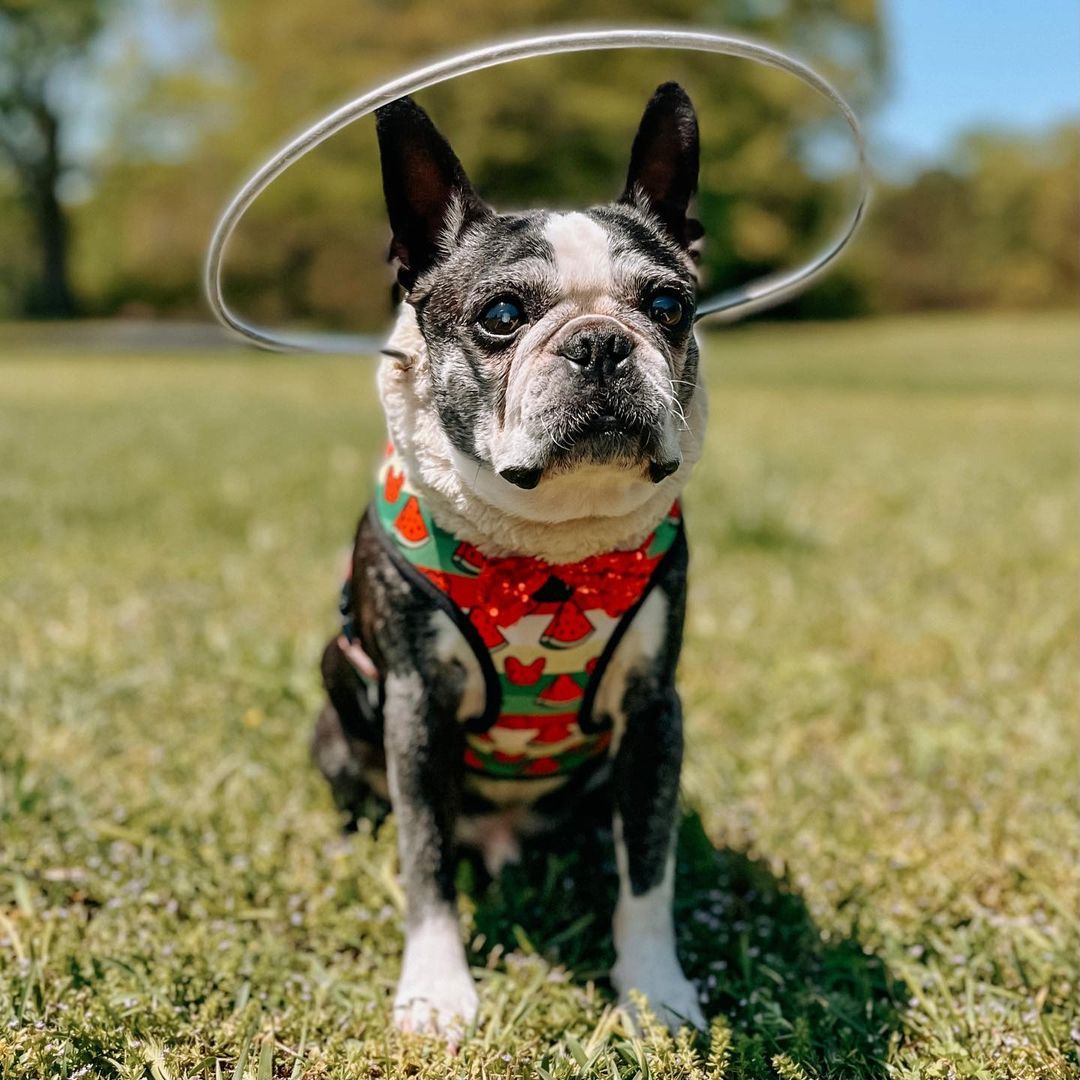Your Cart is Empty
Frenchiestore pet supply - Shop Frenchie pajamas, French Bulldog clothing, front D ring harnesses, leashes & more made for French Bulldogs
Frenchiestore pet supply - Shop Frenchie pajamas, French Bulldog clothing, front D ring harnesses, leashes & more made for French Bulldogs
Frenchiestore pet supply - Shop Frenchie pajamas, French Bulldog clothing, front D ring harnesses, leashes & more made for French Bulldogs

Patellar luxation is one of the leading causes of lameness in dogs. Although it is rarely caused by injury, it can result in significant pain and suffering for your pet if allowed to degenerate. It is important to get the condition checked right away by your vet as this condition will only get worse in time, not better as some may believe. In order to help you understand just what patellar luxation is and what risks it holds for your dog, we decided to create this guide. It explains exactly what you need to know about the meaning, causes and symptoms of patellar luxation in dogs and French Bulldogs in particular and how to treat this condition.
WHAT IS PATELLAR LUXATION IN DOGS?
Patellar luxation occurs when a dog’s patella slides out of place in the knee, usually far to one side or the other. It is also referred to as a "trick knee". The term is made up of two separate words: patella and luxation. The patella is simply a dog’s kneecap. Every dog has two knee caps, one on each rear leg. Luxating on the other hand means “out of place” or “dislocation”. Ordinarily, a dog’s patella sits at the front of the stifle joint, what passes for a dog’s knee joint. When it functions properly, the patella should ride smoothly in a groove along the femur which allows better joint flexibility and leverage for the knee.
But when the groove is too shallow, it can cause the patella to slide out of place and move to one side or the other. When the patella slips out of the femoral groove and rests on the inner side of the dog’s leg, it is regarded as a medial luxation. When it rests on the outside, it is a lateral luxation. The disease is most commonly associated with young dogs, but it often only becomes evident as the dog grows. According to Prevalence studies the disease occurs more in female dogs than male dogs and may be seen in cats as well.
WHAT ARE THE DIFFERENT GRADES OF PATTELLAR LUXATION AND WHAT DO THEY MEAN?
Patellar luxation in dogs usually occurs in grades. These grades determine the seriousness of the affliction and how much treatment the dog is likely to need. There are generally four grades.
WHAT DOG BREEDS ARE PRONE TO LUXATING PATELLAS?
As patellar luxation is basically hereditary, it is useful to know if your dog is one of those associated with the disease. The dog breeds prone to the disease include the following:
WHAT ARE THE CAUSES OF PATTELLAR LUXATION IN DOGS?
Studies indicate that patellar luxation is mostly genetic or congenital, with dog breeds passing them down from generation to generation. It rarely happens due to trauma or injury to the dog’s knee.It is a developmental disorder that results in prevention of an adequately deep and wide femoral groove. This is usually caused because the dog has a patella ligament that is attached too far inward. The patella ligament runs from the bottom of the patella to the tibia. When the thigh muscles, which are attached to the top of the patella contract, it pulls the patella ligament which then straightens the knee joint.When it is attached too far inward, it causes the patella to pull against the femoral groove. After a while, the constant movement will wear down the groove and cause the patella to luxate.
HOW DO YOU KNOW IF YOUR FRENCHIE OR DOG HAS LUXATING PATELLA?
Depending on what stage your dog’s patella luxation has degenerated to, you may be able to tell if they have the disease.Unfortunately, it’s quite unlikely that you’ll find out until the patella has started to dislocate. You can usually tell from your dog’s sitting posture or how the dog walks. Due to the pain cause by the dislocated patella, an affected dog’s movement would be accompanied by a hopping motion. Eventually, the dog may refuse to put any weight on the leg, holding it permanently off the ground.If both legs are affected, the dog may move in a permanently crouched gait or may even walk with both legs off the ground.
WHAT HAPPENS IF YOU DON'T TREAT YOUR DOG'S LUXATING PATELLA?
Untreated patellar luxation in dogs can lead to severs disability, it will not improve with time as some may assume. Every time the patella dislocates, it damages the cartilage lining the inside of the joint, leading osteoarthritis. This will also cause your dog a lot of pain. Continuous rubbing of the patella on the outside of the groove will eventually expose bone and this can lead to infection. In puppies, serious deformation of the limb can occur from the constant dislocation.In all dogs, the continually abnormal position of the patella will eventually destabilize the knee and cause a rupturing of the cranial cruciate ligament.
WHAT ARE THE TREATMENT OPTIONS FOR LUXATING PATELLA IN PETS ?
Thankfully, it is possible to treat patellar luxation in dogs and cats. You may consider natural remedies which may include supplements and physical therapy or invasive treatment such as surgery. It is important to mention that you may not have many options if your dog’s condition has degenerated far enough.
AU NATURAL - HOMEOPATHIC TREATMENT LUXATING PATELLA IN DOGS
It is possible for you to adopt homeopathic, alternative medicine non-surgical treatment and care if your dogs' condition is still mild.
You can try a range of natural remedies including but not limited to:
INVASIVE - SURGICAL TREATMENT LUXATING PATELLA IN DOG
For cases from grade 3 to 4 you may be limited on treatment options other than surgery. When done correctly, and early enough, surgery will help rehabilitate your dog’s knees and repair any damage to the ligaments.Surgery will ordinarily entail moving the patella ligament and fixing it to the proper position. The femoral groove will also be deepened so the patella will stay in place. The capsule around the knee will also be tightened.DID YOU KNOW ? Frenchiestore helps dogs worldwide one harness at a time.Since January 2019 we have launched the Frenchiestore Back 2 Health Program which gives one free Health Harness to any dog that is recovering from surgery, going through physical therapy, water therapy or any other health related issues.
CAN YOU PREVENT YOUR DOG FROM DEVELOPING LUXATING PATELLA?
Unfortunately, patellar luxation in dogs is genetic and difficult to prevent. Although exercise can help prevent or reduce the impact on the dog’s knees but it may not prevent the condition. Keep your dog's weight down with the proper amount of exercise and diet to give your pet the best chance at a healthy pain free life.
We write our informative Pawsletters due to questions we get daily. If you have a particular question or subject you want us to address please write us at hello@frenchiestore.com, DM on Instagram or leave a comment below.
October 24, 2023
My 6 month old Toy Pom seems to have displaced her Left Hind Leg knee. I have calmed her down considerably as she was very active. In the morning she walks normally but later on she run on three legs and not stepping on the floor. As the day goes, she alternates between 3 and 4 legs. Will the problem sort itself out as she grows or is it wise to have it seen to?
Regards Yvonne
August 19, 2021
HI,
I have just been told that the frenchie that I bought and supposed to be flying sunday has a grade 1 luxating patella. I am unsure which questions to ask or if I should look for another pup. I paid full price and if it stays grade 1 then all would be good. Do you recommend asking any other questions or another pup?
Thanks so much!
Comments will be approved before showing up.



Helpful information on the French Bulldog dog breed.
We will also notify you with new releases and special offers.
Informational posts about French Bulldogs. Tips and helpful advice on the Frenchie breed and other breeds.
Sign up to get information & expert advice about pets' health and safety. We will also notify you with new releases and special offers.
Sharee Taylor
October 24, 2023
My Frenchie is 6.5 months 13.3kg not over weight and today was diagnosed with grade 3 luxating patella. Vet advised to monitor and see how he goes, due to his age and the involved surgery as he doesn’t at this stage show much pain or excessive limping. Mild limping when he is running around on uneven ground. Unsure what to do as I don’t want him to get arthritis etc he is a baby.